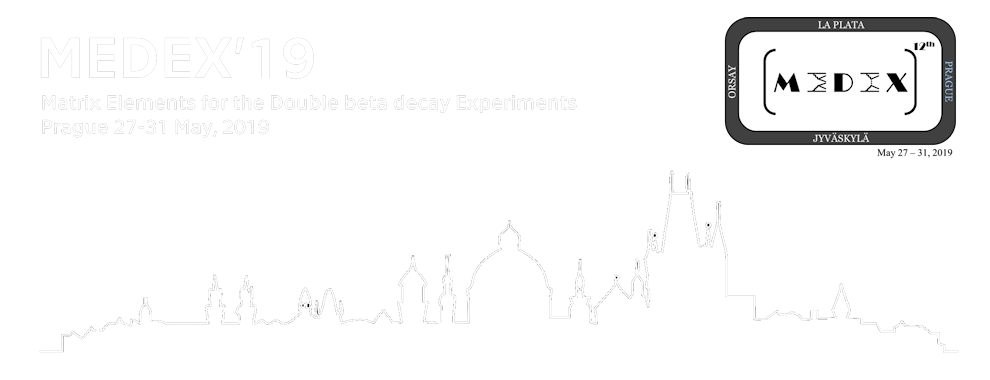Speaker
Dr
Jenni Kotila
(University of Jyväskylä)
Description
In spite of several attempts by many groups (for review see e.g. [1]), neutrinoless double beta ($0\nu\beta\beta$) decay
has not yet been observed. Nonetheless, this observation remains crucial for understanding lepton number
violation. After the discovery of neutrino oscillations [2], attention has been mostly focused
on the mass mechanism of $0\nu\beta\beta$, wherein the three species of neutrinos have
masses $m_i$ and couplings to the electron neutrino $U_{ei}$.
However, in view of the difficulties to observe the mass mechanism, investigations of other mechanisms are also in order. These non-standard mechanisms can be divided into short-range and long-range mechanisms. They
were previously studied by Doi et al. [3] and Tomoda [4], who investigated L-R
models [5], and by Ali et al. [6], who provided a general framework for the investigation
of non-standard models. Recently, we have performed systematic study for all possible short-range non-standard mechanisms [7] and all possible long-range non-standard mechanisms [8].
The aim of this study was twofold: I) to provide explicit formulas for the nuclear matrix elements (NMEs) and phase-space factors
(PSFs) from which the decay rate for one or a combination of mechanisms operating at the same time can be calculated; II) to provide numerical values of the
NMEs and PSFs obtained by making use of the interacting boson model for the NMEs
[9] and of exact Dirac wave functions for the PSFs [10].
[1] M. J. Dolinski, A. W. P. Poon, W. Rodejohann, submitted for publication in the Annu. Rev. of Nucl. Part. Sci. 69 (2019), [arXiv:1902.04097].
[2] Y. Fukuda et al. [Super-Kamiokande Collaboration], Phys. Rev. Lett. 81, 1562 (1998); Q. R. Ahmad et al. [SNO Collaboration], Phys. Rev. Lett. 89, 011301 (2002); K. Eguchi et al. [KamLAND Collaboration], Phys. Rev. Lett. 90, 021802 (2003).
[3] M. Doi, T. Kotani, H. Nishiura, K. Okuda and E. Takasugi, Prog. Theor. Phys. 66, 1739
(1981) Erratum: [Prog. Theor. Phys. 68, 347 (1982)]; M. Doi, T. Kotani, H. Nishiura and
E. Takasugi, Prog. Theor. Phys. 69, 602 (1983).
[4] T. Tomoda, Rept. Prog. Phys. 54, 53 (1991).
[5] J. C. Pati and A. Salam, Phys. Rev. D 10, 275 (1974) Erratum: [Phys. Rev. D 11, 703 (1975)]; R. N. Mohapatra and J. C. Pati, Phys. Rev. D 11, 566 (1975); G. Senjanovic and R. N. Mohapatra, Phys. Rev. D 12, 1502 (1975); M. Doi, T. Kotani and E. Takasugi, Prog. Theor. Phys. Suppl. 83, 1 (1985); M. Hirsch, H. V. Klapdor-Kleingrothaus and O. Panella, Phys. Lett. B 374, 7 (1996).
[6] A. Ali, A. V. Borisov and D. V. Zhuridov, Phys. Rev. D 76, 093009 (2007) [arXiv:0706.4165v3].
[7] L. Graf, F. F. Deppisch, F. Iachello and J. Kotila, Phys. Rev. D 98, 095023 (2018); L. Graf, F. F. Deppisch, F. Iachello and J. Kotila, to be published.
[8] L. Graf, F. F. Deppisch, F. Iachello, J. Kotila and J. Ferretti, to be published.
[9] J. Barea and F. Iachello, Phys. Rev. C 79, 044301 (2009); J. Barea, J. Kotila and F. Iachello, Phys. Rev. C 87, 014315 (2013); J. Barea, J. Kotila and F. Iachello, Phys. Rev. C 91, 034304 (2015).
[10] J. Kotila and F. Iachello, Phys. Rev. C 85, 034316 (2012).

